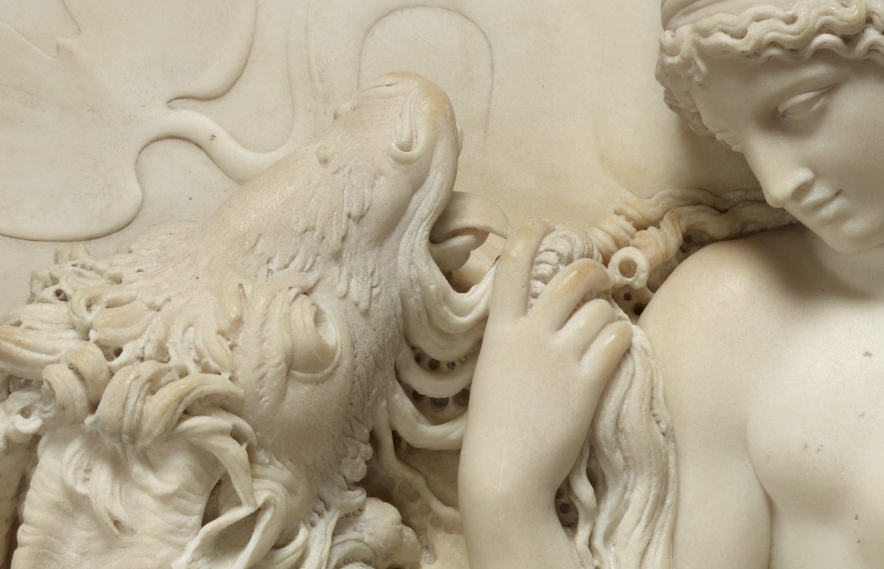Slithery, scary, and sometimes sexy, fantastical sea creatures abound in European art across the centuries

Two Fishermen on a Sea Creature, about 1270, Franco-Flemish. J. Paul Getty Museum. Ms. Ludwig XV 3, fol. 89v
Shark Week is upon us, which means the Web is flooding with a sea of shark puns, pictures, and stories. Just as many of us land-locked humans are rushing to DVR new shark programming this week, the people of yesteryear shared their fascination with the oceans and their mysterious depths through art.
Humans have always sought to uncover with what lies beneath, and images of the mighty who have conquered the sea, whether by boat, whale, dolphin, or submersible bubble, will always remain as testaments to bravery, exploration, and the excitement of the unknown.
While we have no sharks in sight here at the Getty, we have things much more mystical and just as frightening to encounter in the night. I bring to you myths, legends, and stories of the deep.
Siren Songs

Applique with Scylla (detail), about 300–275 B.C., Greek. Silver and gold, 2 7/16 x 2 13/16 in. The J. Paul Getty Museum, 96.AM.111.2. Gift of Barbara and Lawrence Fleischman. Photo: Bruce White Photography
What do ancient sailors and modern coffee snobs both fear? The siren. The mermaidesque mascot of Starbucks is none other than ancient sea beauty that lured passing sailors to shipwreck and death. In The Odyssey, Odysseus escapes the clutches of an entire gang of sirens only to be faced with yet another she-sea-monster, the twin-tailed beast Scylla. Though the name Scylla translates to “puppy” in Greek, she was a true killer. If you ever hear barking when you’re out at sea, pray that that she is at least bringing you a cuppa.
Aquatic Miracles

Tobias and the Angel, 1478, Master of Guillaume Lambert. Tempera colors, gold paint, and iron gall ink on parchment, 5 3/4 x 3 7/8 in. The J. Paul Getty Museum, Ms. 10, fol. 186
While the mysteries of the deep can be frightening, they also offer stories of miraculous triumph. In one Biblical story depicted a medieval prayer book, Tobias uses the entrails of a monstrous fish to cure his father’s blindness. In bestiaries—a type of medieval book about imaginary beasts, real-world animals, and nature—you can read moral lessons about fish and other creatures (like comparing a sedentary whale-like aquatic mammal to a wily devil in this post’s first image).
Dolphins, flying fish, whales, and other aquatic animals were among the stars of these tales. My favorite is about a sea monster who lured sailors into the depths by standing as still as an island. That is, until the sailors would comfortably settle for the evening and the monster would plunge into the depths. Don’t trust the devil! I mean…islands. Don’t trust islands.
Sea Monster Snacks

Andromeda (detail), 1710–16, Massimiliano Soldiani-Benzi. Bronze, 19 1/2 x 13 1/8 x 8 1/8 in. The J. Paul Getty Museum, 97.SB.61.1
The story of Andromeda is delightfully horrifying. Her mom just couldn’t keep her mouth shut and had to boast about her beauty to the gods. (Hint: never boast to the gods!) To appease offended Poseidon, god of the sea, her parents lovingly chained Andromeda to a rock to be devoured by a monster. She was saved in the end—don’t worry—but her frightening brush with frights of the ocean lives on in sculpture and story.
Belly of the Beast
What’s worse than being captured by a sea monster? Arguably, being swallowed by one.
Remember Jonah and the whale? Jonah fled from God’s calling and was cast overboard and swallowed by a whale. The moral of the story was simple: disobeying God will cast you into the belly of the beast.

Initial E: Jonah Cast into the Sea, about 1270, Franco-Flemish. Tempera colors and gold leaf on parchment, 18 1/2 x 12 11/16 in. The J. Paul Getty Museum, Ms. Ludwig I 8, v2, fol. 181
Riding the Waves

Venus Reclining on a Sea Monster with Cupid and Putto (detail), 1785–87, John Deare. Marble, 13 1/4 in. x 33 in. The J. Paul Getty Museum, 98.SA.4

Sea monsters were also symbols of erotism and fantasy. The goddess Venus is often depicted as reclining oh-so-casually on a monster, in this relief where it is depicted as a dragon with a rather playful tongue. Two precious putti keep the love burning with a flaming torch and cupid’s bow.
This romance-drenched painting of Scylla and the sea god Glaucus is a tad more Disneyesque. Glaucus pulls back his beard to reveal an arrow in his heart. He’s not worried, just in love (with a barking sea monster, but there’s no accounting for taste).

Glaucus and Scylla (detail), about 1640–44, Laurent de la Hyre. Oil on canvas, 57 1/2 x 46 1/2 in. The J. Paul Getty Museum, 84.PA.13

Venus on the Waves (detail), 1769, François Boucher. Oil on canvas, 104 5/16 x 33 7/8 in. The J. Paul Getty Museum, 71.PA.54
Fellow humans, let us take Shark Week with a grain of salt. Art reminds us that there are worse and weirder sea monsters in the oceans.
Thanks to Getty Museum curators Scott Allan, Anne-Lise Desmas, Bryan Keene, Elizabeth Morrison, and David Saunders for these seaworthy selections.




Always good to see John Deare’s superb work. Thank you for sending this out. Holly (Marjorie) Trusted V&A, London.
I would be interested in any references that are made to dolphins in art.